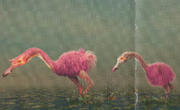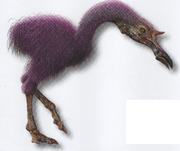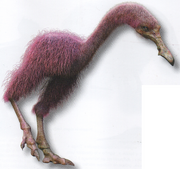
A couple of Struthiops philipkdicki in search of food in the mangroves.
Systematic: Aves (Bird), struthioniforme (ostriches Group) struthionidé.
Etymology: Struthiops drift Struthio, name of the ostrich, and philipkdicki is an homage to Philip K. Dick, an American writer whose published works mainly belong to the genre of science fiction.
Cousin 21st Century: The common ostrich of Africa, Struthio camelus.
Size: 2.30 to 2.50 meters for males, 2 meters for females.
Distribution: Along the coast of Eurafrique. They prefer tropical climates where the species gathers in flocks.

A male Struthiops philipkdicki
Morphology: The body of Struthiops has all of the ostriches of the 21st Century. They have retained some traits of their cousins from the 21st Century as toe claws and a long neck. Males sport a front-peak a bit like pterosaurs- and a toothed beak (or rather "horny") in the form of rake. The speed and balance Struthiops philipkdicki are insured by long legs, while the legs are fitted with elastic bearings forming genuine bouncing soles. With their powerful claws, his didactyle feet (two fingers, as in our ostrich) are as formidable weapons. The Struthiops philipkdicki is able to sprint to 80 km / h, 10 km / h more than its current cousin. But her wings have completely regressed and feathers turned into long pink filaments. Their color "flashy" is due to the fact that these austruches as our flamingos, especially appreciate the neo-shrimp, rich in carotene.

A female Struthiops philipkdicki
Ecology and Reproduction: The future of ostriches are confined to the coastal environment. They live in herds of about ten individuals mixed with those of their friendly companions, small Tringapterus. Males are polygamous and dominant (this was already the case in ostriches in the 21st century). Excellent runners, they effectively protect their harems against intruders. Females lay between 3 and 10 eggs. The brains of these "neo-ostriches" is quite large, so they can go into REM sleep (i.e. dream, like their distant cousins). Some individuals suffering from somnambulism, sometimes get lost at night, becoming easy prey in the forest. By the coastlines, predators include Neocidaris schwarzenheggeri.
